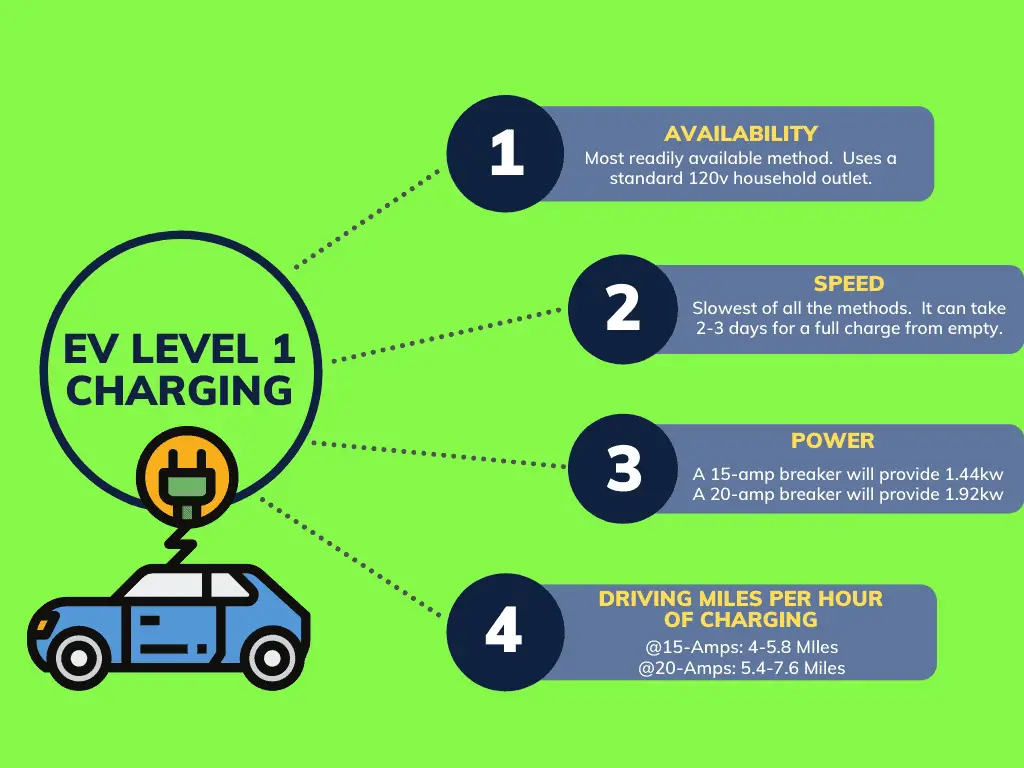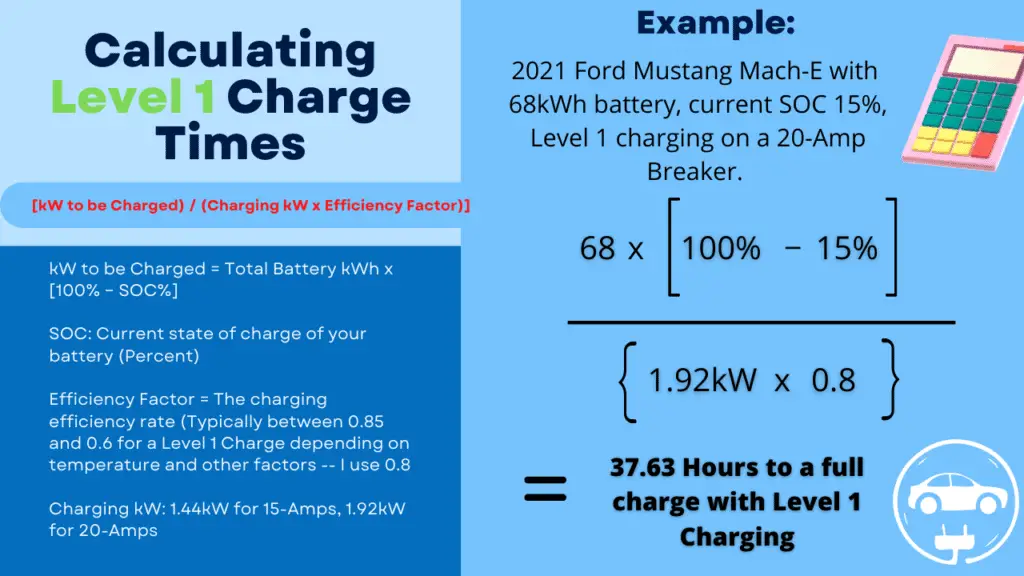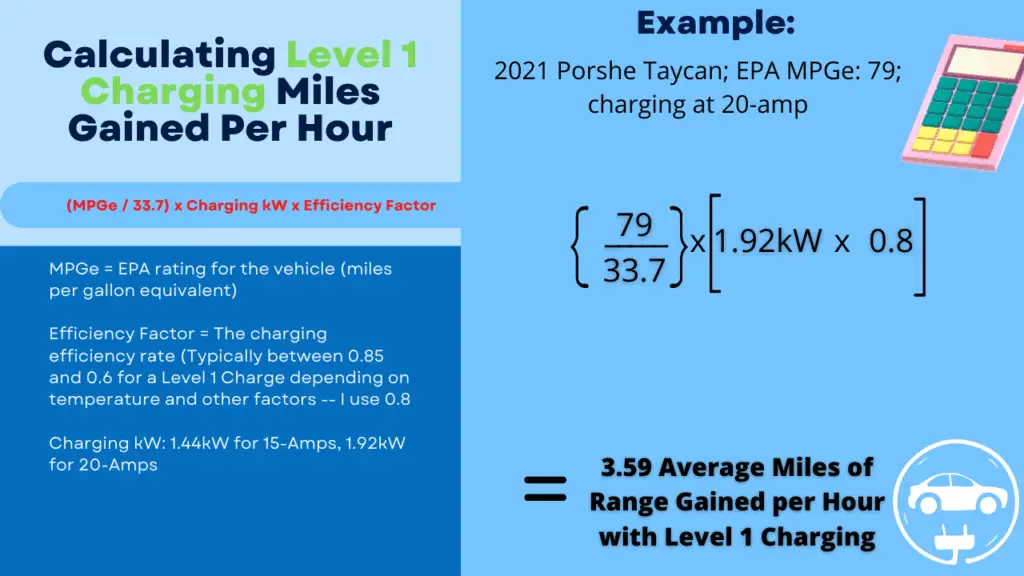Just about every new EV that you purchase today will throw in a Level 1 EVSE (Electric Vehicle Supply Equipment) for you to charge at home, and some now even include a Level 2 EVSE. The first question everyone has regarding their Level 1 EVSE is how quickly an EV can be charged.
An average EV will gain about 4-7 miles per hour of level 1 charging and can take 2-3 days to fully charge from empty. Level 1 charging is the slowest EV charging method and is done at 120 volts of alternating current from a typical household receptacle with either 15 or 20 amps on a dedicated breaker.
In this quick article, we’ll take a look at how the top 11 best selling EV models stack up against each other when it comes to level 1 charging, and how to quickly calculate these numbers yourself.
If you’re interested in how long it would take to charge an EV at Level 2 and Level 3 charging, you can check out my other article here.
How Fast is Level 1 EV Charging?
Level 1 charging at 120-volts will charge at a speed of 1.44kw with a 15-amp breaker and 1.92kw with a 20-amp breaker. These speeds will fully charge an average electric vehicle in 2-3 days and replenish about 4-7 driving miles per hour of charging.
Level 1 charging uses the standard outlet in your home that you’re used to plugging almost everything into. That outlet has 120 volts, which is essentially the pressure behind the electricity.
If you trace the wires from your outlet back through the walls, they’ll all converge at your main breaker box. Inside that box you’ll generally see that the 120-volt breakers are either 15-amp or 20-amp in size.
A 15-amp breaker might be used for a bedroom, whereas the kitchen would have a 20-amp breaker to handle the appliances that you’ll be using there.

It is recommended to have a dedicated breaker for your EV when charging, which means that you won’t be powering anything else except your EV from that breaker.
A breaker will run at 80% of the number on the breaker itself. So, a 20-amp breaker will actually operate at 16 amps. It can go a little higher for short periods before tripping, but it doesn’t want to exceed 80%.
That being said, a 15-amp breaker will run at 12 amps, and the 20-amp breaker will run at 16. The total kilowatts that they’ll put out is laid out below:
- 15-amp breaker: 120-volts x 12-amps = 1,440 watts, or 1.44kw
- 20-amp breaker: 120-volts x 16-amps = 1,920 watts, or 1.92kw.
How Long Does it Take to Charge an EV with Level 1 Charging?
To calculate how long it will take to charge an EV with level 1 charging, you need to first identify how many kWh (kilowatt hours) you need to replace in your EV battery.
Take the following steps to figure out how to determine the kWh to be charged:
- Step 1: Find the net battery capacity of your vehicle (or usable portion of the battery for propulsion) using this website
- Step 2: See what percentage your battery is at and subtract that number from 100
- Step 3: Multiply the number from Step 2 as a percentage (0.XX) by the total net battery capacity
- Step 4: Multiply the total kilowatts of your breaker (1.44 for a 15-amp breaker, or 1.92 for a 20-amp breaker) by the charging efficiency (I’m using 0.8, which is close to typical in decent conditions)
- Step 5: Divide the answer in Step 3 by the answer in Step 4

Example:
Let’s look at the Tesla Model Y on the top row of the table below. Let’s pretend that the battery is at 5% state of charge and the total Net Capacity is 75kWh. The breaker we’re using is a 20-amp breaker and we’ll roll with a 20% inefficiency (or 80% efficiency factor).
- 100 – 5 = 95% that needs to be recharged
- 0.95 x 75kWh = 71.25kWh to be recharged
- 71.25kWh / 1.92 = 37.11 Hours to charge before charging inefficiencies are factored in
- 37.11 hours / 0.8 = 46.4 hours to charge
I did all of the calculations in the table below by calculating the charging time for replenishing 100% of the battery capacity and not a fraction of it.
This table shows the Level 1 charging times (in hours) with 15 and 20-amp breakers for the top 11 selling EV models in the last year.
| EV Model | Year | Net Battery Capacity (kWh) | Level 1 Charging Time (Hours) @15A from Empty | Level 1 Charging Time (Hours) @20A from Empty |
|---|---|---|---|---|
| Tesla Model Y | 2020 | 75 | 65 | 49 |
| Tesla Model 3 | 2020 | 57.5 | 50 | 37 |
| Ford Mustang Mach E | 2021 | 68 | 59 | 44 |
| Chevy Bolt EV | 2021 | 60 | 52 | 39 |
| Volkswagen ID.4 | 2021 | 77 | 67 | 50 |
| Nissan Leaf | 2021 | 37 | 32 | 24 |
| Audi e-tron | 2021 | 86 | 75 | 56 |
| Porsche Taycan | 2021 | 71 | 62 | 46 |
| Tesla Model S | 2020 | 95 | 82 | 62 |
| Hyundai Kona Electric | 2021 | 64 | 56 | 42 |
| Tesla Model X | 2020 | 95 | 82 | 62 |
How Many Miles of Driving Range per Hour with Level 1 Charging?
On average, an electric vehicle will gain 4-7 miles of driving range per hour of Level 1 charging. Level 1 charging provides 1.44-1.92kW of power per hour, and an average EV will get 3-5 miles of range per kilowatt hour.
| Level 1 Charging Breaker Size | Driving Miles Gained per Hour of Charging |
|---|---|
| 15 Amp | 4 – 5.8 |
| 20 Amp | 5.4 – 7.6 |
You can calculate a solid ballpark estimate of the total miles of range gained per hour for your particular model, or any model that you’re looking at.
- Step 1: Locate your EV’s EPA MPGe rating (miles per gallon equivalent) with this website and divide the MPGe by 33.7
- Step 2: Multiply your answer from Step 1 by either 1.44kW for a 15-amp breaker, or 1.92kW for a 20-amp breaker
- Step 3: Multiply your answer from Step 2 by the charging efficiency factor (Again, I use 0.8, but you could use as low as 0.6 for really cold weather, or 0.9 great conditions)

Example:
A 2020 Tesla Model Y has an EPA combined MPGe of 111 (you can use city, or highway if that’s what your primary driving consists of), we’ll be charging with a 20-amp breaker, and our efficiency factor will be 0.8.
- 111 / 33.7 = 3.29 miles per kilowatt hour
- 3.29 x 1.92kw = 6.32 miles of range before inefficiencies
- 6.32 x 0.8 = 5.1 miles of range per hour of Level 1 charging at 20-amps
Below you can check out the top selling 11 models over the last year and how many miles they gain per hour of Level 1 charging with 15 and 20 amps.
| EV Model | Year | Combined EPA MPGe | Miles Gained Per Hour with Level 1 Charging at 15A | Miles Gained Per Hour with Level 1 Charging at 20A |
|---|---|---|---|---|
| Tesla Model Y | 2020 | 111 | 3.79 | 5.05 |
| Tesla Model 3 | 2020 | 131 | 4.47 | 5.96 |
| Ford Mustang Mach E | 2021 | 93 | 3.18 | 4.24 |
| Chevy Bolt EV | 2021 | 118 | 4.03 | 5.38 |
| Volkswagen ID.4 | 2021 | 97 | 3.31 | 4.41 |
| Nissan Leaf | 2021 | 111 | 3.79 | 5.05 |
| Audi e-tron | 2021 | 78 | 2.66 | 3.55 |
| Porsche Taycan | 2021 | 79 | 2.7 | 3.59 |
| Tesla Model S | 2020 | 109 | 3.72 | 4.96 |
| Hyundai Kona Electric | 2021 | 120 | 4.1 | 5.47 |
| Tesla Model X | 2020 | 90 | 3.08 | 4.1 |
